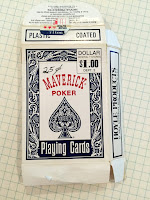Welcome to part two of instructions for making a mini-book from a playing card box. Part one covered setting up the cover and making the pages. Part two covers assembling the pages into signatures and binding the book.
ASSEMBLING PAGES INTO SIGNATURES.
After you've cut and folded the inside pages for your book, you'll want to arrange them in a pleasing order and group them into signatures. A signature is a group of pages bound together in a book. Using four to five pages per group, assemble three groups of pages, and those groups will become the signatures. Below are the pages that will become my signatures. The first two groups have 5 pages each, and the third group has only four because the center spread is an envelope that is folded twice, so will be bulkier than the others.
TEMPLATES FOR BINDING.
Next, you will prepare to punch the holes for binding by making two templates. The first template will be a guide for punching the nine holes in the spine of your book, and the other will be a guide for punching the three holes in each of your signatures. Use sturdy card stock or a manila file folder to make these templates so they will not tear in use.
SPINE TEMPLATE.
For the spine template, cut a rectangle the size of the center panel of the box. The panel of my box was a bit less than 3/4" wide and exactly 3.5" tall.
Next place the spine template next to a ruler and make a pencil dot at the 3/4", 1-3/4" and 3" points (see below). Using the ruler across each of those points, make three dots in a row, equally spaced. As you can see in the second rectangle below, you will end up with nine dots in three rows of three.
Use the 9-hole spine template to place the holes in the center panel or spine of the book. I use a Japanese book drill, my favorite bookbinding tool, because I like clean, crisp holes. If you don't have a book drill, you can use an awl.
SPREAD TEMPLATE.
The second template is for the three holes that go in the center of each spread. Using card stock or a manila file folder, cut a piece about 1-1/4" to 1-1/2" wide and 3.5" tall (the height of the spine). Fold this piece in half and use one row of the spine template to punch holes through the center fold of the spread template. Mark the top of the template so that, in case of slight variations, all of your spreads will be punched in the same three places.
Open the first spread of pages and straighten it so that all pages in the spread are aligned, then use binder clips to secure both sides to keep it straight while you punch. Leave the binder clips on after you punch the holes, because they will help keep the spread in place as you bind the book, as well.
PREPARING THE WAXED LINEN.
After you've punched holes in all of your signatures, you are ready to measure the waxed linen thread you'll use to bind the book. Unwind the waxed linen thread (or waxed dental floss) and use the spine of the book to measure 12 spine-lengths of thread. That's a bit more than you will need, but it's always better to have too much rather than too little. Cut the thread and thread the needle, leaving a tail of about 2 inches, and you're ready to start sewing.
You'll add the three spreads to the book one at a time, using the same length of thread. There will be a knot at the beginning and a knot at the end, but no cutting until after the final knot.
Select either the first or the last of the three spreads and align the three holes in the spread with the appropriate three holes in the spine. I started with the last spread, so I lined up the holes with the last set of holes in the spine and started to sew.
Pull the thread from the INSIDE center hole of the spread to the outside center hole of the book and make a knot inside the spread (see below). Then bring the needle back through the top hole of the book and the spread. Go BACK out through the center, being careful not to push the knot through your hole. Bring the thread out of the center hole, then bring it back into the bottom hole of the book spine and through the bottom hole in your spread and back through the outside of the book. Leave the thread hanging outside that center hole, then add your CENTER spread to the book. Cross that thread from the outside horizontally to the center hole of the center spread, and follow the same pattern, then repeat with the last spread.
Your spine will look like this, with long strips of thread between each hole vertically and very short strips of thread at the center horizontally.
Congratulations! Your book is bound and ready to decorate, embellish and add journalling!


























